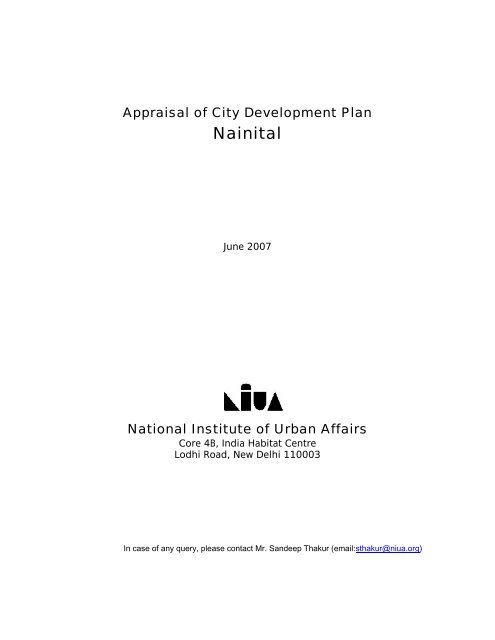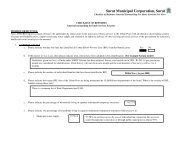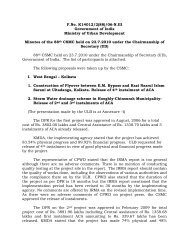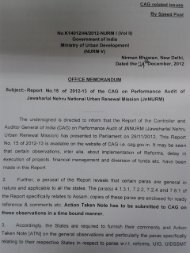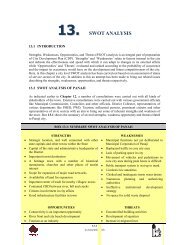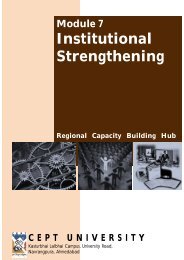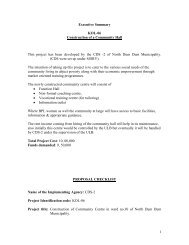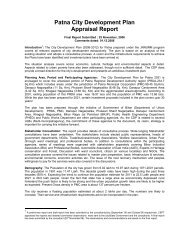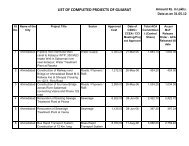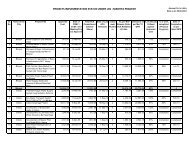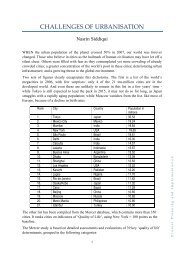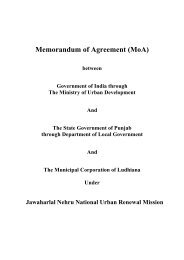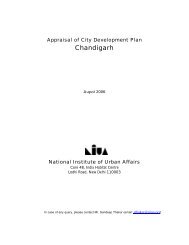Appraisal of City Development Plan: Nainital - JnNURM
Appraisal of City Development Plan: Nainital - JnNURM
Appraisal of City Development Plan: Nainital - JnNURM
You also want an ePaper? Increase the reach of your titles
YUMPU automatically turns print PDFs into web optimized ePapers that Google loves.
<strong>Appraisal</strong> <strong>of</strong> <strong>City</strong> <strong>Development</strong> <strong>Plan</strong><strong>Nainital</strong>June 2007National Institute <strong>of</strong> Urban AffairsCore 4B, India Habitat CentreLodhi Road, New Delhi 110003In case <strong>of</strong> any query, please contact Mr. Sandeep Thakur (email:sthakur@niua.org)
<strong>Appraisal</strong> <strong>of</strong> <strong>City</strong> <strong>Development</strong> <strong>Plan</strong>: <strong>Nainital</strong>The <strong>City</strong> <strong>Development</strong> <strong>Plan</strong> (CDP) <strong>of</strong> <strong>Nainital</strong> gives a good idea about the situation in thecity, its future perspective and vision, and the investment plan for the city. Three aspects,however, were completely missing in the first draft <strong>of</strong> the CDP that was submitted inDecember 2006 and reviewed by the National Institute <strong>of</strong> Urban Affairs (NIUA) i.e. (i)the existing situation analysis was not supposed to be based on any sample survey butshould be based on the real situation analysis and the supporting data was expected to begathered concerned institutions which were involved in the provision <strong>of</strong> urban basicservices in the city, (ii) Capital Investment plan was provided for 2025 and no estimatesfor the purpose were provided for the JNNURM period and (iii) Financial Operating <strong>Plan</strong>(FOP) was not provided. A number <strong>of</strong> suggestions were made and city <strong>of</strong>ficials wereasked to incorporate additional information in the revised CDP as discussed in Annex 1.<strong>City</strong>’s response after the first set <strong>of</strong> comments:Based on the initial submission <strong>of</strong> the CDP, the comments mentioned above werecommunicated to the city. As is clear from these comments, the CDP needed majorrevisions. The revised CDP was received by NIUA on 1 June 2007, which furtherneeded some clarifications. The revised and final version <strong>of</strong> the CDP was submitted onJune 5 2007, which was again appraised by the Institute.NIUA’s response:The revised CDP has incorporated most <strong>of</strong> the comments made on the earlier draft CDPs.Chapter 8 has been rewritten which is titled as "<strong>City</strong> Investment <strong>Plan</strong>, Strategies andImplementation <strong>Plan</strong>". The sectoral city investment plan for the JNNURM period andfinancial operating plan have also been incorporated in this chapter.There are major changes in the revised CDP; however, the authorities have shown theirdata limitations at the city level. For instance, in Section 3.1.3 on Situation Analysis, ithas been quoted “Adequate secondary data at household level on water supply, sanitation,solid waste management etc. are not available. Consequently, data from socio-economicsurvey at household level were analysed and the findings are discussed in this section.
Wherever secondary data is available, these are used in the situation analysis,supplemented by further field studies.”Considering the conditions prevailing in the city we accept what has been presented inthe CDP for the present. But it is required that the city will provide more information inthis regard in a year's time which would not be based on socio-economic survey andshould be based on the real databases maintained at the city level. The Ministry <strong>of</strong> Urban<strong>Development</strong> may take appropriate action in this regard.Subject to the caveats/qualification mentioned above, the CDP is now is inaccordance with JNNURM toolkit number 2.
Annex 1<strong>Appraisal</strong> <strong>of</strong> <strong>City</strong> <strong>Development</strong> <strong>Plan</strong>: <strong>Nainital</strong> (First round)The CDP <strong>of</strong> <strong>Nainital</strong> gives a fairly clear idea <strong>of</strong> the situation in the town at present and itsfuture plans. The CDP gives both statistical and spatial information.Stakeholder consultationsSection 1.3 (p. 2) indicates that three stakeholder consultations were held in the town forthe preparation <strong>of</strong> CDP. While the stakeholders seem to cover various interest groupsand individuals, the details <strong>of</strong> only one stakeholder meeting is available in the Annexure.The details <strong>of</strong> the consultations should be provided. It should contain details such as thedate <strong>of</strong> the meeting, type <strong>of</strong> stakeholders who attended the meeting and a brief summary<strong>of</strong> the outcomes.DemographyThe current population <strong>of</strong> <strong>Nainital</strong> is estimated at 44,000. In 2001, as per Census 2001,the population <strong>of</strong> the town was 38,000. The decadal growth rate <strong>of</strong> the town has variedconsiderably since 1901, showing high to very high growth rates which fall to low andnegative growth rates (p. 8). However, since 1991, the decadal growth rate has beenabove 20 per cent and the annual growth rate has been projected at 3% between 2005 and2009 and at 3.5% between 2010 and 2014 (Annex 3.1.1).The floating population <strong>of</strong> <strong>Nainital</strong> (mainly tourists) was recorded at 5.18 lakhs in 2005.Since most <strong>of</strong> the tourists come during three months, the daily average tourist arrival inthese three months works out to 5,756. This figure has been added to the populationprojected for the town.A survey <strong>of</strong> 100 households was conducted in the town to give an idea <strong>of</strong> the presentsituation. The purpose <strong>of</strong> this survey is not clear as the CDP cannot be based on theresults <strong>of</strong> a small sample survey.Urban Poor<strong>Nainital</strong> has 10 main slums that account for 21 per cent <strong>of</strong> the total population <strong>of</strong> thetown. The total population living in these slums is given as 9287 (p. 13). Many <strong>of</strong> theslums are within the catchment area <strong>of</strong> the lake.The entire section on the urban poor (section 3.1.2 ) is based on a survey done <strong>of</strong> a smallnumber <strong>of</strong> poor households. This section states that no recent studies are available on theextent <strong>of</strong> poverty levels in the town. Despite this, at least some information would beavailable with the agencies dealing with the poor. Information should be collected fromthese agencies and analysed and the information obtained from the survey can
supplement this analysis. The investment requirements indicated on p. 132 should havea basis and this should be provided in the situation analysis section.Economic BaseThe main economic base <strong>of</strong> the town is tertiary sector activities related to small trade andenterprises, hotel business, transport and such other activities and to a lesser extentrelated to educational institutions and government <strong>of</strong>fices.Land useThe <strong>Nainital</strong> Lake Region Special Area <strong>Development</strong> Authority (NLRSADA) is theagency responsible for the preparation <strong>of</strong> development plan for the region. <strong>Nainital</strong> has aMaster <strong>Plan</strong> 2011, which gives a good idea <strong>of</strong> the planning approach the town willfollow. It provides for the preservation <strong>of</strong> forest area and water bodies and alsodemarcates a prohibited area where a number <strong>of</strong> restrictions on development have beenput in place. The physical growth characteristics map (Map 3.3.1) should have a legendin English as the rest <strong>of</strong> the map is in English.A <strong>Nainital</strong> Lake Conservation project is being undertaken in the town at a cost <strong>of</strong> Rs. 65crores, <strong>of</strong> which Rs. 47.96 crores is earmarked for <strong>Nainital</strong> Lake and the rest Rs. 16.85crores for four other lakes in the region. This project is funded by the Central and StateGovernments in the ratio 70:30 (p. 31). Till May 2006, Rs. 28.67 cr. were released, <strong>of</strong>which Rs. 22.15 cr. had been utilised.Existing Situation AnalysisA discussion on municipal infrastructure and services has been provided in Section 3.4.This section gives details <strong>of</strong> the existing status <strong>of</strong> basic infrastructure and services andalso outlines the key issues related to the current deficiencies and future demand.However, the services levels, including the financial aspects, have not been presented in atabular format. This may be done to give an idea <strong>of</strong> the present situation at a glance.Water supplyThe water supply in <strong>Nainital</strong> is operated and maintained in the city by Uttaranchal JalSansthan (UJS). UJS also undertakes small budget capital works. Large capital worksand overall planning is carried out by Uttaranchal Pey Jal Nigam. Tubewells are themain source <strong>of</strong> water supply for <strong>Nainital</strong> town meeting 93% <strong>of</strong> its total supply. Theremaining 7% is drawn from surface source. The average availability <strong>of</strong> water in thetown is given as 135 lpcd (p. 36). The supply hours vary from 6 to 24 hours in differentareas.The entire town <strong>of</strong> <strong>Nainital</strong> is covered by water supply network, barring some pockets.The unaccounted for water, as per the CDP, may be up to 30% or more. The pipelines in
the old city are old and dilapidated and need replacement. The O&M problems and keyissues in water supply are detailed out on p. 40 to 42.Sewerage and sanitationThe town has a sewerage system which was laid in the beginning <strong>of</strong> 19 th century. A fewdecades later some branch sewers were laid in different parts <strong>of</strong> the town. With thegrowth in population the sewer system became inadequate. The <strong>Nainital</strong> Lake alsostarted getting polluted due to the overflow <strong>of</strong> sewage in stormwater drains, whichultimately discharges into the Lake. New trunk and branch sewers were laid from time totime to address this problem.At present, 8 MLD <strong>of</strong> sewage is generated in the town, <strong>of</strong> which almost 82% is collectedby the sewerage system and the remaining 18% is treated by individual septic tanks.Currently, there is a gap in treatment capacity <strong>of</strong> 3 MLD, which is being taken care <strong>of</strong> bythe <strong>Nainital</strong> Lake Conservation project, 2002. Under this project, two STPs <strong>of</strong> 5 MLDcapacity each have been proposed, <strong>of</strong> which one STP is under construction. All thewastewater discharge channels from almost all the areas into the lake have been coveredand intercepted by sewerage system under this project. Key issues related to thesewerage system have been presented on pages 45 and 46.Storm water drainageThe whole town <strong>of</strong> <strong>Nainital</strong>, wherever roads or brick pavements exist, has some kind <strong>of</strong>side drains that lead to storm water drains, except in slums and some peripheral areas.However, the drains need cleaning, repair and remodelling. The key issues related tostorm water drains are presented on p. 48.Solid Waste ManagementThe quantity <strong>of</strong> municipal waste generated daily in the town varies between 12 to 18 MT.No primary collection is done in the town by <strong>Nainital</strong> Nagar Palika Parishad (NNPP).The door-to-door collection has been given to resident committees. NNPP collects wastefrom bins, containers and open collection points. The existing solid waste transportationvehicles do not have access to about 40-50% areas <strong>of</strong> the town and so the remainingwaste is left uncollected. This waste finds its way into storm water drains and hill slopes(p. 49).The present solid waste disposal site is located at a distance <strong>of</strong> 2 kms. from the city. Thewaste is dumped on this site down the hill slope. The waste is not treated or processed.Land for the proposed disposal site has not yet been identified. The key issues in solidwaste management are detailed out on p. 52.Roads and Transport
Different stretches <strong>of</strong> roads in <strong>Nainital</strong> are maintained by NNPP and PWD. The trafficflow in the town causes congestion as there is limited road space available. Trafficrestrictions are imposed to mange traffic. There are no intermediate modes <strong>of</strong> publictransport in the town. Taxis are available for inter-city trips and rickshaws are availablefor journeys between specific points (p. 56). Most <strong>of</strong> the internal roads are single lanewith a few exceptions. Pedestrian movement in the town is affected because <strong>of</strong> theabsence <strong>of</strong> footpaths. Key issues related to roads and transport are presented on p. 56.Heritage and TourismINTACH has listed the important cultural and heritage resources <strong>of</strong> <strong>Nainital</strong>. The townalso has a rich tradition <strong>of</strong> religious fairs and festivals. The Government <strong>of</strong> Uttaranchalhas adopted a clear mandate to develop tourism in the state as one <strong>of</strong> the prime movers <strong>of</strong>the economy. The Master <strong>Plan</strong> <strong>of</strong> the town also focuses on tourism development (p. 58).The challenges and key issues related to heritage and tourism have been presented onp.60.Since <strong>Nainital</strong> has been selected under JNNURM mainly for its heritage aspect, aseparate document will need to be prepared for the heritage aspect based on thesupplementary toolkit prepared for this purpose (available on the website <strong>of</strong> the Ministry<strong>of</strong> Urban <strong>Development</strong>).Urban Governance and Institutional Set upThere are about ten institutions that are involved in the provision <strong>of</strong> infrastructure andservices in <strong>Nainital</strong>. While the NNPP is the local body, the NLRSADA is a regionalbody. The other institutions involved are all state level bodies. The institutional matrixgiven on p. 67 indicates the function <strong>of</strong> each <strong>of</strong> these agencies by sector. The majorfunctions <strong>of</strong> NNPP are given on p.71. The NLRSADA has been entrusted with functionsrelated to housing, building plan sanction, area development and internal roadconstruction, amongst others (p. 72).The CDP indicates the timeframe for some <strong>of</strong> the reforms and the status <strong>of</strong> a few otherreforms. Full-scale transfer <strong>of</strong> functions, as envisaged under 74 th CAA, is expected totake place in three years time (p. 73).Financial pr<strong>of</strong>ileChapter five and eight <strong>of</strong> the CDP are related to financial pr<strong>of</strong>ile <strong>of</strong> institutions andcapital investment plan respectively. Chapter six and seven deal with city SWOTanalysis & vision and sector strategies and identification <strong>of</strong> projects respectively.Financial Pr<strong>of</strong>ile <strong>of</strong> NNPP and Other Agencies:
Chapter 5 <strong>of</strong> the CDP reviews and analyses the existing financial situation <strong>of</strong> keyagencies involved in the execution and maintenance <strong>of</strong> municipal infrastructure. Incomeand expenditure details are provided well for <strong>Nainital</strong> Nagar Palika Parishad (NNPP),Uttaranchal Jal Sansthan (UJS)-<strong>Nainital</strong> Division and NLRSADA.NNPPNNPP has a small functional domain and has small fiscal powers as well. Section 5.3provides a detailed analysis <strong>of</strong> NNPP finances. The revenue receipts <strong>of</strong> NNPP increasedfrom Rs.35.9 million in 2001-02 to Rs.39.3 million in 2004-05 and then declined toRs.35.8 million in 2005-06. The corresponding figures for revenue expenditure wereRs.36.3 million, Rs.44 million and Rs.39.6 million respectively. The share <strong>of</strong> stategovernment grants in revenue receipts ranged between 46% to 62% whereas own revenuereceipts ranged between 64% to 38% in the last five-year period. The main source <strong>of</strong>own revenues are house/property tax and non-tax receipts. Own revenue receiptsincreased from Rs.13.5 million to Rs.19.2 million at an annual rate <strong>of</strong> 8.8 percent duringthe time period <strong>of</strong> 2001-02 to 2005-06 whereas the state government grants declined from22.4 million to Rs.16.5 million at an annual rate <strong>of</strong> (-) 7.6 percent. This shows that theNNPP’s dependency on state government grants has declined and realization from itsown revenue receipts has increased. The reason for the decline in state transfers is notexplained in the CDP. The functions and tax/charges related to water supply werehanded over UJS-<strong>Nainital</strong> Division in the year 2002-03. Water charges are to be leviedand collected by the UJS after the year 2001-02. On the other hand, on the expenditureside, only about 10 percent <strong>of</strong> revenue expenditure has been incurred, on an average, onoperation and maintenance works. In the past five-year period, 90 percent <strong>of</strong> the revenueexpenditure has been on establishment and salaries etc. This is understandable becausemost <strong>of</strong> the functions <strong>of</strong> NNPP are staff oriented functions. Operation and maintenanceworks related to water supply were handed over to UJS-<strong>Nainital</strong> Division in the year2002 and no decline in establishment and salaries head in the year 2002-03 has beenobserved. The reason for no decline in expenditure on establishment and salaries headfor the period <strong>of</strong> 2003-04 to 2005-06 could not be understood from the data provided.The main problem with the city’s finances is that the NNPP depends substantially onstate government grants and powers delegated to NNPP under the Municipal Act havenot been realised much. There is considerable room for review and revision <strong>of</strong> the currenttax rates. Un-assessed properties, mainly in the newly developed areas <strong>of</strong> the city are stillto be brought in property tax base. Tax rates are not being revised regularly, as the lastrevision was made in the year 2000-01. The demand to collection ratio in case <strong>of</strong>property tax increased from 55% in 2002-03 to 75% in 2004-05 but then declined to 42%in 2005-06. The above-mentioned deficiencies are the main reasons for lower collectionsfrom own revenue receipts.UJS-<strong>Nainital</strong> DivisionUJS is responsible for delivery <strong>of</strong> services related to water supply and sewerage since2002-03 onwards. Section 5.5 provides an analysis <strong>of</strong> UJS finances. The revenue
eceipts <strong>of</strong> UJS increased from Rs.24.9 million in 2003-04 to Rs.36.4 million in 2005-06.The corresponding figures for revenue expenditure were Rs.64.17 million and Rs.80.02million respectively. For the past three years UJS has shown a deficit <strong>of</strong> Rs.39.3, 63.5and 43.4 million. It clearly indicates that UJS’s finances are weak and since thesedeficits have been paid by the state government it shows that UJS is highly dependent onthe state government financial assistance. On the expenditure side, on an average 80percent <strong>of</strong> revenue expenditure has been incurred on operation and maintenance works.However, it is not clear from the data provided whether electricity expenditure isincluded in it or not. About 17 to 24 percent <strong>of</strong> the revenue expenditure has beenincurred on establishment, wages and salaries head.The main problem with the finances <strong>of</strong> UJS is its substantial dependency on stategovernment grants. Only 67.5 percent <strong>of</strong> the collections are made against the demand <strong>of</strong>water related taxes and charges etc. There is an outstanding balance <strong>of</strong> Rs.18.4 millionagainst the total demand <strong>of</strong> water related taxes and charges etc. as on 31 st March 2006.Other reasons for low collections are no revision or late revision <strong>of</strong> tax rates.NLRSADAOne <strong>of</strong> the main functions <strong>of</strong> NLRSADA is the preparation <strong>of</strong> master plan andimplementation <strong>of</strong> building byelaws, provision <strong>of</strong> housing, roads and bridges, slumdevelopment and poverty alleviation. Section 5.4 provides an analysis <strong>of</strong> NLRSADAfinances. The revenue receipts <strong>of</strong> NLRSADA increased from Rs.11.44 million in 2004-05 to Rs.12.80 million in 2006-07. The corresponding figures for revenue expenditurewere Rs.6.24 million and Rs.9.43 million respectively. <strong>Development</strong> charges is the maincomponent <strong>of</strong> NLRSADA’s income and has contributed about 25.8 percent <strong>of</strong> thereceipts followed by sub-division charges, compounding fee and interest income with23.7, 16.9 and 16.8 percent respectively. Other sources <strong>of</strong> income are map submissionfee and stamp duty etc.On the other hand, on expenditure side, on an average 63 percent <strong>of</strong> revenue expenditurehas been incurred on establishment, wages and salaries account followed by operationand maintenance with 37 percent. NLRSADA earned pr<strong>of</strong>its in 2004-05 to 2006-07.Overall, the present financial position <strong>of</strong> NLRSADA is good as there are no outstandingloan payments.Vision and strategiesThe vision statement <strong>of</strong> <strong>Nainital</strong>, which has been provided by the citizens, reads as “Iwant to live in an ecologically sound and beautiful <strong>Nainital</strong> that is well managed withefficient public services, a healthy economy and a natural and built environment thatretains its unique character” (p. 98). For some <strong>of</strong> the sectors the vision, issues andstrategies are given in detail (e.g urban renewal) while for others it has not been provided.This should be provided for all the sectors.
The ranking <strong>of</strong> infrastructure priorities is given on p. 97. While the table gives theranking, the graph is misleading and is not required. It should be deleted.Capital Investment <strong>Plan</strong>Chapter eight gives a fair idea about the capital investment plan, strategies andimplementation plan. The total estimated capital investment required for providingefficient services to the present population and future population <strong>of</strong> NNPP by the year2025 is Rs.533.4 crores (page 126). But Table 8.1 (p. 127) gives a different figure andshows the requirement as Rs.954.6 crores. Of this, projects for Rs.690.5 crores have beenproposed for roads and transport which is about 72.3 percent <strong>of</strong> the total identifiedinvestment, followed by Rs.90.45 crores for urban renewal and redevelopment whichcomes to 9.4 percent and others. Sector-wise Investment <strong>Plan</strong> is well presented andprovides detailed information on the topic.Summary <strong>of</strong> Capital Investment – <strong>Nainital</strong>Sl. No. Sector Capital Investment(Rs. crores)1 Roads and Transport 690.52 Urban renewal and redevelopment 90.453 Urban poor/Slums 46.24 Storm water drainage 23.85 Water supply 55.16 Solid waste management 20.07 Sewerage and sanitation 18.08 Heritage and Tourism 7.29 Street Lights 3.4Total 954.6In Table 8.5 (p.130) the development <strong>of</strong> new disposal site requiring Rs. 2.0 crores hasbeen repeated in item 10 and item 17. This needs correction or clarification if they aredifferent. The bulk <strong>of</strong> investment requirement under roads and transport sector is for aRopeway. Of the total requirement <strong>of</strong> Rs. 690.5 cr. for this sector, Rs. 400 cr. is for anew ropeway. This, as per the CDP, will be for tourism development and for giving analternate mode <strong>of</strong> transport to local population.The bulk <strong>of</strong> the funds required for the urban poor is for housing, with very small amountsrequired for provision <strong>of</strong> services. This, according to the CDP, is because water supplyand solid waste management are included in the overall city plan.
Financial Operating <strong>Plan</strong> and Investment Sustenance <strong>Plan</strong>:<strong>Nainital</strong> is eligible for 80% <strong>of</strong> the total project cost as grant finance from the CentralGovernment. State government would be financing 10% <strong>of</strong> the total project cost andremaining 10 percent <strong>of</strong> the project cost is to be contributed by NNPP and parastatals.“Steps are being initiated to meet the requirements <strong>of</strong> mandatory and optional reforms,institutional and financial reforms at the ULB/Parastatal level in order to strengthen thefinancial system and improve financial management in these agencies. Modalities formeeting the requirement <strong>of</strong> 50% <strong>of</strong> the operation and maintenance costs, as per theJNNURM guidelines, would be worked out and implemented” CDP-<strong>Nainital</strong>.The CDP has not provided any financial operating plan (FOP). Strategies related tohundred percent cost recovery. (page118) should have been justified by the relevantfinancial operating plans. Ten percent <strong>of</strong> financial arrangements for the proposedprojects and hundred percent <strong>of</strong> the operation and maintenance costs for the proposedprojects under JNNURM are to be provided by the involved city-level agencies, whichshould also be made clear in FOP.Improvements to be made to the CDP1. Details <strong>of</strong> stakeholder consultations to be provided in Annex.2. The section on urban poor needs to be re-written based on the comments givenunder ‘urban poor’ in this appraisal note.3. For each service, a table giving the existing status must be provided, which shouldcontain physical as well as financial information.4. The legend <strong>of</strong> Map 3.3.1 should be provided in English.5. A perspective and vision (short term, mid term and long term) for the city usingthe real analytical results (not based on survey), incorporating results <strong>of</strong>stakeholder consultations should be provided.6. Strategies for resource augmentation by city-level institutions to reduce thedependency on state government grants and other transfers should be provided.7. Graph showing ranking <strong>of</strong> infrastructure priorities should be deleted.8. The goals and vision should be linked with the existing situation.9. The sector wise vision, issues and strategies table should be provided for all thesectors.10. Detailed information on agency-wise strategies and capital investment planshould be provided.11. Complete financial operating plan giving a short term, mid term and long-termvisions must be provided.12. Future projections for the needed finances for the proposed projects (ten percent)and future projections for meeting hundred percent <strong>of</strong> the operation andmaintenance cost should be given.13. A separate document, based on the supplementary toolkit for Heritage, needs tobe prepared and submitted for the town.


